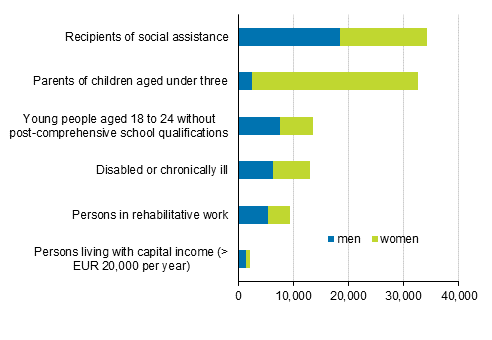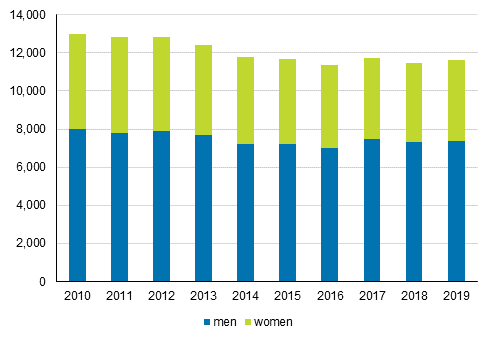Published: 8 April 2021
Number of young people aged 18 to 24 at risk of social exclusion 13,500 in 2019
According to Statistics Finland’s employment statistics, there were 178,500 persons in the other inactive population in 2019. The other inactive population includes persons aged 16 or over who do not belong to the labour force, nor are they students, pensioners or persons performing military or non-military service. Among the other inactive population, there were 13,500 young people aged 18 to 24 without post-comprehensive school qualifications. The group of the other inactive population also includes parents of small children, people with disabilities or chronically ill, as well as persons living with income support or capital income.
Sub-groups of other inactive population in 2019

The other inactive population group includes persons who cannot be classified under any other main type of activity 1) . According to Statistics Finland's employment statistics, there were 178,500 other economically inactive persons in 2019. The group had slightly more women than men: 94,400 (53%) One in two was aged 15 to 34. The biggest ten-year age group was those aged 25 to 34 (51,900), of whom 61 per cent were women. One-third of the other inactive population group had been born abroad.
In this examination, sub-groups have been formed for the group in question. The sub-groups are not mutually exclusive.
Close on one-fifth (34,200) of the other inactive population group received social assistance in December 2019. There were slightly more men than women among those receiving social assistance: 18,500 (54%)
Of the other inactive population, 32,600 persons, or nearly one-fifth, were parents of children aged under three. The majority (92%) of them were women.
In all, 30,600 young people aged 18 to 24 were in the other inactive population, of whom 13,500 (44%) had not completed post-comprehensive school qualifications. Close on 60 per cent of young people without post-comprehensive school qualifications were men.
The number of persons with disabilities or chronically ill was 13,000 (7%) in the other inactive population. Information on disability or chronical illness is based on the Ministry of Economic Affairs and Employment's register data. This group includes personal customers of the Employment and Economic Development Office, whose possibilities of finding suitable a job, maintaining a job or advancing in work have been found to have diminished considerably.
In all, 9,500 (5%) persons in the group of the other inactive population were involved in rehabilitative work activities. Men made up close on 60 per cent of the group. Rehabilitative work is intended for persons who have been without work for a longer time.
Of the other inactive population, 2,100 received capital income more than EUR 20,000 during the year. The majority (64%) of those living with capital income were men.
Number of young people at risk of social exclusion has fallen in the 2010s
According to Statistics Finland’s employment statistics, there were 13,500 young people aged 18 to 24 who had not completed post-comprehensive school qualifications in the group of the other inactive population in 2019. Among them, 1,900 (14%) were parents of children aged under three, most (92%) of whom were mothers. Without parents of small children, the number of these young people was 11,600, the majority (64%) of whom were men.
The number of other inactive young people without post-comprehensive school qualifications and with no children aged under three has fallen after 2010. In 2019, their number was 1,400 lower (11%) than ten years earlier. The share of men has grown slightly during the 2010s.
Other inactive young people aged 18 to 24 without post-comprehensive school qualifications by sex in 2010 to 2019 *

* Parents of children aged under three are not included.
1) The population is divided by their main type of activity to the active and inactive population. The active population includes the employed and the unemployed. The inactive population includes persons aged 0 to 14, students and pupils, pensioners, persons in military service and in non-military service, and others in the inactive population. The other inactive population group includes persons who cannot be classified under any other group.
Source: Employment Statistics, Statistics Finland
Inquiries: Meri Juuti 029 551 3061, Elina Pelkonen , info@stat.fi
Head of Department in charge: Hannele Orjala
Publication in pdf-format (255.5 kB)
- Reviews
-
- 1. Economic dependency ratio was 133 in 2019 (8.4.2021)
- Tables
-
Tables in databases
Pick the data you need into tables, view the data as graphs, or download the data for your use.
Appendix tables
Updated 8.4.2021
Official Statistics of Finland (OSF):
Employment [e-publication].
ISSN=2323-6825. profession and socio economic position 2019. Helsinki: Statistics Finland [referred: 28.12.2025].
Access method: http://stat.fi/til/tyokay/2019/01/tyokay_2019_01_2021-04-08_tie_001_en.html

